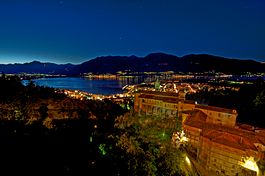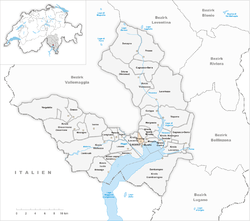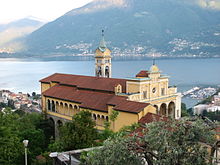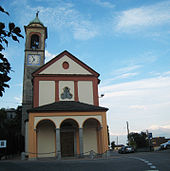- Orselina
-
Orselina Country Switzerland 
Canton Ticino District Locarno 46°11′N 8°48′E / 46.183°N 8.8°ECoordinates: 46°11′N 8°48′E / 46.183°N 8.8°E Population 768 (Dec 2009)[1] - Density 396 /km2 (1,025 /sq mi) Area 1.94 km2 (0.75 sq mi)[2] Elevation 449 m (1,473 ft) Postal code 6644 SFOS number 5121 Surrounded by Avegno, Locarno, Minusio, Muralto Website www.orselina.ch
Profile (Italian), SFSO statisticsOrselina is a municipality in the district of Locarno in the canton of Ticino in Switzerland.
Contents
History
Orselina is first mentioned in 1182 as Concilio Meziano. In 1323 it was mentioned as Orsarina.[3] During the Middle Ages and into the Early Modern Period, it (along with Burbaglio and Muralto) was part of the Vicinanza of Consiglio Mezzano, which belonged to the Locarno and Ascona region. The castle SS Abbondio e Biagio, was given in the 12th Century as a fief by the Bishop of Como to the Muralto family. The castle was destroyed in the 14th Century. The political municipality of Orselina was formed in 1803 and included Muralto. Up until 1850, Orselina dominated the municipality, thanks to the economic weight of its livestock and vineyards. However, even by the 19th Century, the two towns had developed differently. While in the upper part (Orselina) the traditional socio-economic structure remained, the lower part along the lake (Muralto) grew industrially and urbanized. The differences in the towns led to a division of the municipality in 1881 into Orselina and Muralto.
The 16th Century church of S. Bernardo was initially dependent on the Church of S. Vittore in Muralto. Starting in 1816, the church's pastor came from Locarno. It became the center of its own parish in 1966.
During 1930-80, the number of German residents surpassed that of the Italian-speaking. But by 2000, the ratio was the reversed (380 to 460). From the beginning of the 20th Century Orselina developed into a holiday and tourist destination.
Geography
Orselina has an area, as of 1997[update], of 1.94 square kilometers (0.75 sq mi). Of this area, 0.35 km2 (0.14 sq mi) or 18.0% is used for agricultural purposes, while 1.45 km2 (0.56 sq mi) or 74.7% is forested. Of the rest of the land, 0.45 km2 (0.17 sq mi) or 23.2% is settled (buildings or roads) and 0.03 km2 (7.4 acres) or 1.5% is unproductive land.
Of the built up area, housing and buildings made up 17.0% and transportation infrastructure made up 4.6%. while parks, green belts and sports fields made up 1.5%. Out of the forested land, 69.1% of the total land area is heavily forested and 4.6% is covered with orchards or small clusters of trees. Of the agricultural land, 1.0% is used for growing crops and 17.0% is used for alpine pastures. Of the unproductive areas, 1.5% is unproductive vegetation and.[4]
The municipality is located in the Locarno district, on a hill above Muralto. It consists of the village of Orselina and the settlement of San Bernardo.
Coat of arms
The blazon of the municipal coat of arms is Argent a castle gules embattled alla Ghibellina and between its towers a fleur-de-lis of the same.[5]
Demographics
Orselina has a population (as of December 2009[update]) of 768.[1] As of 2008[update], 18.0% of the population are resident foreign nationals.[6] Over the last 10 years (1997–2007) the population has changed at a rate of -3.2%.
Most of the population (as of 2000[update]) speaks Italian (53.1%), with German being second most common (36.7%) and Dutch being third (2.7%).[7] Of the Swiss national languages (as of 2000[update]), 318 speak German, 18 people speak French, 460 people speak Italian, and 6 people speak Romansh. The remainder (64 people) speak another language.[8]
As of 2008[update], the gender distribution of the population was 46.9% male and 53.1% female. The population was made up of 292 Swiss men (38.0% of the population), and 68 (8.9%) non-Swiss men. There were 333 Swiss women (43.4%), and 75 (9.8%) non-Swiss women.[9]
In 2008[update] there were 3 live births to Swiss citizens and were 10 deaths of Swiss citizens. Ignoring immigration and emigration, the population of Swiss citizens decreased by 7 while the foreign population remained the same. There were 2 non-Swiss men and 6 non-Swiss women who immigrated from another country to Switzerland. The total Swiss population change in 2008 (from all sources, including moves across municipal borders) was a decrease of 24 and the non-Swiss population change was an increase of 5 people. This represents a population growth rate of -2.5%.[6]
The age distribution, as of 2009[update], in Orselina is; 44 children or 5.7% of the population are between 0 and 9 years old and 54 teenagers or 7.0% are between 10 and 19. Of the adult population, 62 people or 8.1% of the population are between 20 and 29 years old. 65 people or 8.5% are between 30 and 39, 122 people or 15.9% are between 40 and 49, and 124 people or 16.1% are between 50 and 59. The senior population distribution is 141 people or 18.4% of the population are between 60 and 69 years old, 94 people or 12.2% are between 70 and 79, there are 62 people or 8.1% who are over 80.[9]
As of 2000[update] the average number of residents per living room was 0.51 which is less people per room than the cantonal average of 0.6 per room. In this case, a room is defined as space of a housing unit of at least 4 m2 (43 sq ft) as normal bedrooms, dining rooms, living rooms, kitchens and habitable cellars and attics.[10] About 49.4% of the total households were owner occupied, or in other words did not pay rent (though they may have a mortgage or a rent-to-own agreement).[11]
As of 2000[update], there were 399 private households in the municipality, and an average of 1.8 persons per household.[7] In 2000[update] there were 288 single family homes (or 63.0% of the total) out of a total of 457 inhabited buildings. There were 51 two family buildings (11.2%) and 91 multi-family buildings (19.9%). There were also 27 buildings in the municipality that were multipurpose buildings (used for both housing and commercial or another purpose).[12]
The vacancy rate for the municipality, in 2008[update], was 0%. In 2000[update] there were 961 apartments in the municipality. The most common apartment size was the 3 room apartment of which there were 291. There were 108 single room apartments and 140 apartments with five or more rooms.[13] Of these apartments, a total of 391 apartments (40.7% of the total) were permanently occupied, while 552 apartments (57.4%) were seasonally occupied and 18 apartments (1.9%) were empty.[13] As of 2007[update], the construction rate of new housing units was 9.1 new units per 1000 residents.[7]
The historical population is given in the following table:[3]
year population 1596 104 1801 537 1850 782 1880 1,206 1888 227 1900 212 1950 648 1990 854 2000 866 Heritage sites of national significance
The Sacro Monte with the church of Dell’Annunziata and the convent and church of Della Madonna del Sasso e Museo is listed as a Swiss heritage site of national significance.[14]
Politics
In the 2007 federal election the most popular party was the FDP which received 35.82% of the vote. The next three most popular parties were the CVP (22.43%), the SP (18.51%) and the SVP (13.5%). In the federal election, a total of 243 votes were cast, and the voter turnout was 43.5%.[15]
In the 2007[update] Gran Consiglio election, there were a total of 570 registered voters in Orselina, of which 272 or 47.7% voted. 5 blank ballots were cast, leaving 267 valid ballots in the election. The most popular party was the PLRT which received 62 or 23.2% of the vote. The next three most popular parties were; the PPD+GenGiova (with 50 or 18.7%), the SSI (with 49 or 18.4%) and the PS (with 38 or 14.2%).[16]
In the 2007[update] Consiglio di Stato election, 3 blank ballots and 3 null ballots were cast, leaving 266 valid ballots in the election. The most popular party was the PLRT which received 62 or 23.3% of the vote. The next three most popular parties were; the PPD (with 56 or 21.1%), the SSI (with 46 or 17.3%) and the PS (with 45 or 16.9%).[16]
Economy
As of 2007[update], Orselina had an unemployment rate of 2.82%. As of 2005[update], there was 1 person employed in the primary economic sector and about 1 business involved in this sector. 4 people were employed in the secondary sector and there were 3 businesses in this sector. 439 people were employed in the tertiary sector, with 35 businesses in this sector.[7] There were 366 residents of the municipality who were employed in some capacity, of which females made up 46.7% of the workforce.
In 2000[update], there were 371 workers who commuted into the municipality and 225 workers who commuted away. The municipality is a net importer of workers, with about 1.6 workers entering the municipality for every one leaving. About 9.7% of the workforce coming into Orselina are coming from outside Switzerland.[17] Of the working population, 6% used public transportation to get to work, and 50.5% used a private car.[7] As of 2009[update], there were 2 hotels in Orselina.[18]
Religion
From the 2000 census[update], 536 or 61.9% were Roman Catholic, while 195 or 22.5% belonged to the Swiss Reformed Church. There are 115 individuals (or about 13.28% of the population) who belong to another church (not listed on the census), and 20 individuals (or about 2.31% of the population) did not answer the question.[8]
Education
The entire Swiss population is generally well educated. In Orselina about 80.1% of the population (between age 25-64) have completed either non-mandatory upper secondary education or additional higher education (either university or a Fachhochschule).[7]
In Orselina there were a total of 82 students (as of 2009[update]). The Ticino education system provides up to three years of non-mandatory kindergarten and in Orselina there were 8 children in kindergarten. The primary school program lasts for five years and includes both a standard school and a special school. In the village, 30 students attended the standard primary schools and 1 student attended the special school. In the lower secondary school system, students either attend a two year middle school followed by a two year pre-apprenticeship or they attend a four year program to prepare for higher education. There were 23 students in the two year middle school and 2 in their pre-apprenticeship, while 7 students were in the four year advanced program.
The upper secondary school includes several options, but at the end of the upper secondary program, a student will be prepared to enter a trade or to continue on to a university or college. In Ticino, vocational students may either attend school while working on their internship or apprenticeship (which takes three or four years) or may attend school followed by an internship or apprenticeship (which takes one year as a full-time student or one and a half to two years as a part-time student).[19] There were 7 vocational students who were attending school full-time and 3 who attend part-time.
The professional program lasts three years and prepares a student for a job in engineering, nursing, computer science, business, tourism and similar fields. There was 1 student in the professional program.[20]
As of 2000[update], there were 6 students in Orselina who came from another municipality, while 71 residents attended schools outside the municipality.[17]
References
- ^ a b Swiss Federal Statistical Office, MS Excel document – Bilanz der ständigen Wohnbevölkerung nach Kantonen, Bezirken und Gemeinden (German) accessed 25 August 2010
- ^ Arealstatistik Standard - Gemeindedaten nach 4 Hauptbereichen
- ^ a b Orselina in German, French and Italian in the online Historical Dictionary of Switzerland.
- ^ Altitudine, superficie, secondo il genere di utilizzazione, rilevazione 1992/1997, e densità della popolazione, nel 2000 (Italian) accessed 25 October 2010
- ^ Flags of the World.com accessed 10-December-2010
- ^ a b Swiss Federal Statistical Office - Superweb database - Gemeinde Statistics 1981-2008 (German) accessed 19 June 2010
- ^ a b c d e f Swiss Federal Statistical Office accessed 10-December-2010
- ^ a b Popolazione residente, secondo la lingua principale e la religione, nel 2000 (Italian) accessed 23 November 2010
- ^ a b 01.02.03 Popolazione residente permanente (Italian) accessed 23 November 2010
- ^ Eurostat. "Housing (SA1)" (pdf). Urban Audit Glossary. 2007. p. 18. http://www.bfs.admin.ch/bfs/portal/en/index/international/22/lexi.Document.116365.pdf. Retrieved 12 February 2010.
- ^ Urban Audit Glossary pg 17
- ^ 09.02.01 Edifici (Italian) accessed 23 November 2010
- ^ a b 09.02.02 Abitazioni (Italian) accessed 23 November 2010
- ^ "Kantonsliste A-Objekte:Ticino" (in German). KGS Inventar. Federal Office of Civil Protection. 2009. http://www.bevoelkerungsschutz.admin.ch/internet/bs/de/home/themen/kgs/kgs_inventar/a-objekte.parsys.000117.DownloadFile.tmp/ti.pdf. Retrieved 12 July 2010.
- ^ Swiss Federal Statistical Office, Nationalratswahlen 2007: Stärke der Parteien und Wahlbeteiligung, nach Gemeinden/Bezirk/Canton (German) accessed 28 May 2010
- ^ a b Elezioni cantonali: Gran Consiglio, Consiglio di Stato (Italian) accessed 23 November 2010
- ^ a b Swiss Federal Statistical Office - Statweb (German) accessed 24 June 2010
- ^ Settori alberghiero e paralberghiero (Italian) accessed 23 November 2010
- ^ EDK/CDIP/IDES (2010). KANTONALE SCHULSTRUKTUREN IN DER SCHWEIZ UND IM FÜRSTENTUM LIECHTENSTEIN / STRUCTURES SCOLAIRES CANTONALES EN SUISSE ET DANS LA PRINCIPAUTÉ DU LIECHTENSTEIN (Report). http://edudoc.ch/record/35128/files/Schulsystem_alle.pdf. Retrieved 24 June 2010.
- ^ Allievi e studenti, secondo il genere di scuola, anno scolastico 2009/2010 (Italian) accessed 23 November 2010
External links
- Official website (Italian)
- Pro Orselina / Community Activities group - bu (Italian)
Ascona | Brione | Brione sopra Minusio | Brissago | Cavigliano | Centovalli | Corippo | Cugnasco-Gerra | Frasco | Gambarogno | Gordola | Gresso | Isorno | Lavertezzo | Locarno | Losone | Mergoscia | Minusio | Mosogno | Muralto | Onsernone | Orselina | Ronco sopra Ascona | Sonogno | Tegna | Tenero-Contra | Vergeletto | Verscio | Vogorno
Ticino | Districts of Canton Ticino | Municipalities of the canton of Ticino
 Categories:
Categories:- Municipalities of Ticino
- Municipalities of Switzerland
- Cultural property of national significance in the canton of Ticino
Wikimedia Foundation. 2010.







